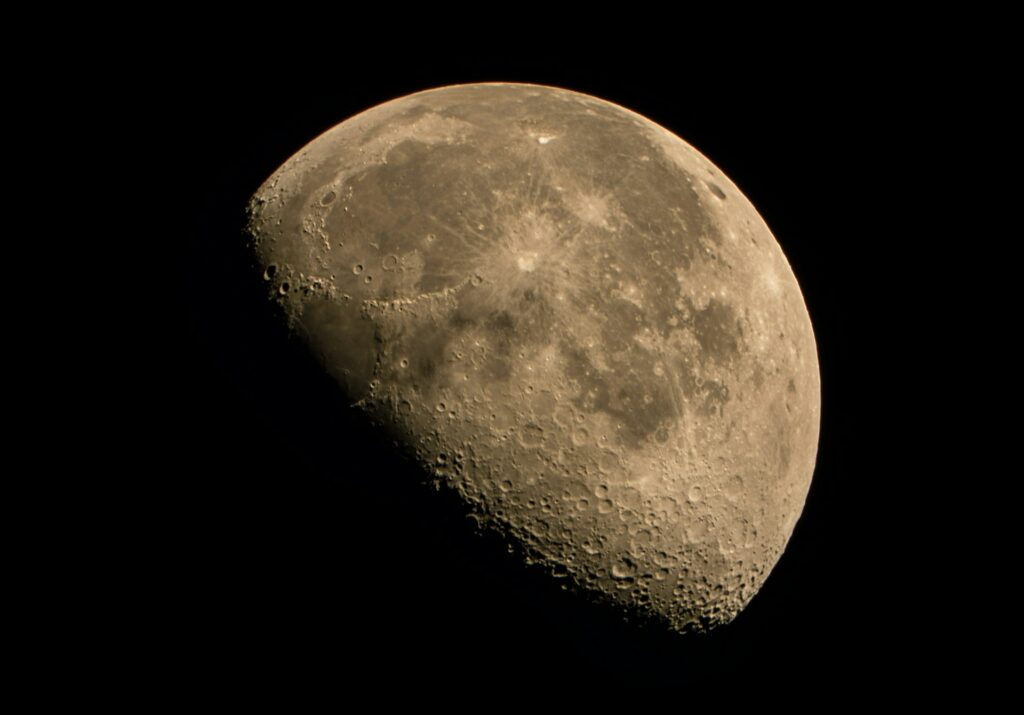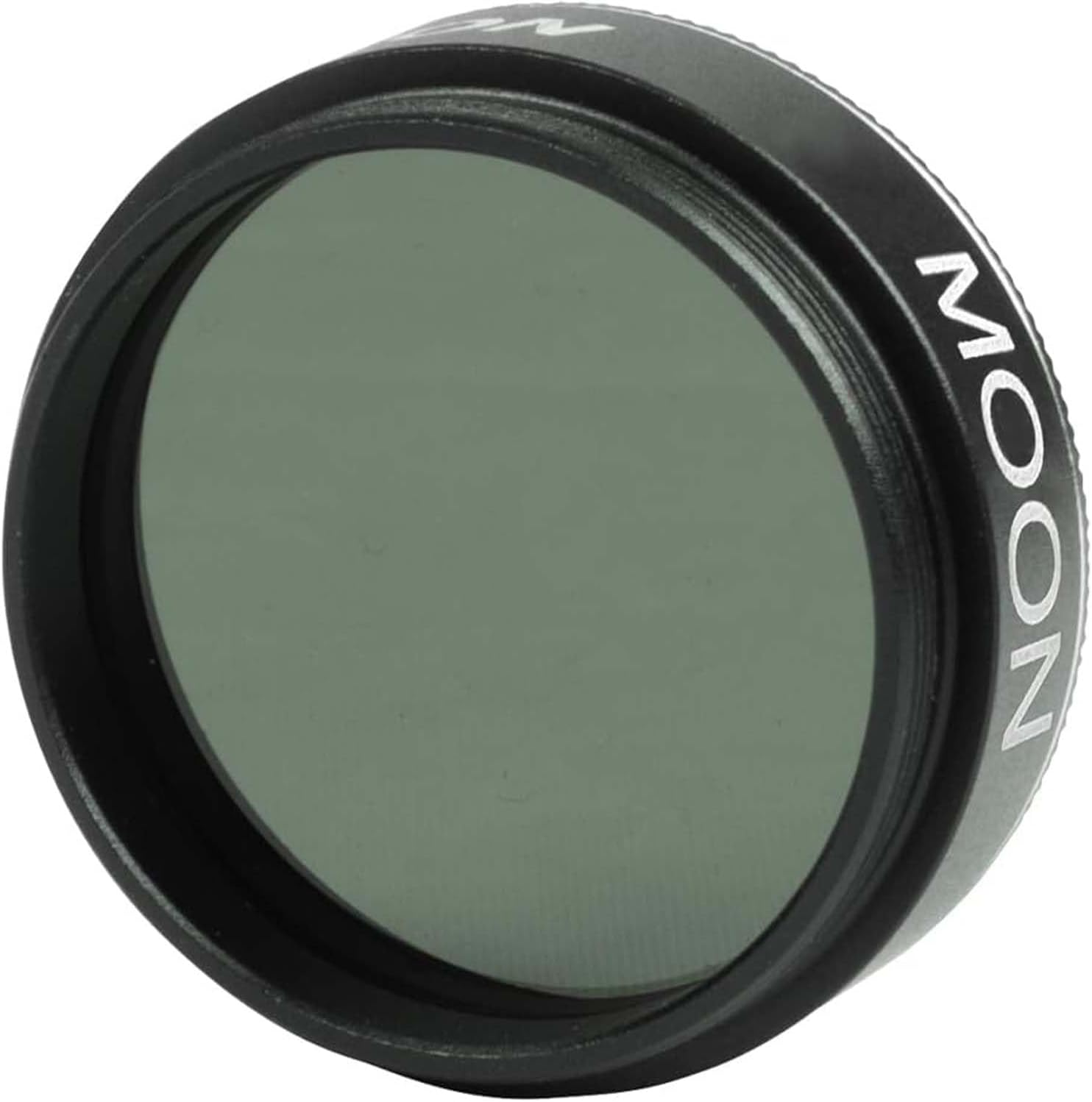Staring up at the night sky, the moon has always captivated our imagination. Telescopes bring us closer, unveiling intricate lunar landscapes, yet there’s a catch. The moon, especially when full, isn’t just bright; it’s incredibly blinding through a telescope.
Which is why using a moon filter is essential for anyone serious about lunar observations. It not only cuts down on glare but also increases contrast, allowing you to see the moon’s craters, valleys, and mountains in crisp detail.
This is especially important when viewing a full moon, where brightness can often wash out finer details. With just one simple addition to your telescope setup, you can elevate your entire experience.
That’s why understanding how to choose and use these filters is important, setting you up for memorable nights with vivid lunar landscapes.

There are different types of moon filter, designed to enhance lunar observations by reducing glare and improving contrast. Here are the main types:
Neutral Density (ND) Filters: These filters reduce the overall brightness without altering the Moon’s natural colour. They are available in fixed densities, such as 13%, 25%, or 50% light transmission. A 13% filter is ideal for observing a full moon, while a 25% filter works well for less bright phases.
Variable Polarizing Filters: These filters allow you to adjust the level of brightness reduction by rotating the filter. They offer flexibility for different lunar phases and telescope apertures. Light transmission can range from 3% to 40%.
Note: This post contains affiliate links. If you buy through these links, I may earn a small commission at no extra cost to you. As an Amazon Associate, I earn from qualifying purchases.
Top Moon Filters For Your Telescope
Celestron 94119-A Moon Filter
One of the top-rated moon filters you’ll find is the Celestron 94119-A 1-1/4 Inch Moon Filter. It stands out for its solid build and consistent performance.
Perfect for anyone just getting serious about their lunar observations, it reduces glare while preserving image clarity. This filter often emerges as a favourite among users for its affordability and quality.
- CLEAR LUNAR VIEWING: Reduce glare and increase contrast of the Moon with the Celestron 1.25” Moon Filter
- MULTIPURPOSE: Also useful for extra bright planets as well as terrestrial viewing over sand or snow (not suitable for viewing the Sun)
- EASY SETUP: Threads onto most 1.25” eyepieces in seconds
- PERFECT PARTNER: Best paired with Celestron SkyMaster Pro ED Porro Prism Binoculars
- UNBEATABLE WARRANTY AND CUSTOMER SUPPORT: Buy with confidence from the world’s #1 telescope brand, based in California since 1960. You’ll also receive a 2-year warranty
The Celestron 94119-A reduces the brightness of the Moon, making it more comfortable to observe. This is especially useful during full moon phases when the brightness can be overwhelming.
By reducing glare, the filter enhances the contrast of lunar features, allowing for better visibility of craters, mountains, and other surface details.
This filter threads onto most 1.25″ eyepieces, making it easy to install and remove. This convenience is appreciated by users who want to switch between different eyepieces quickly.
While primarily designed for lunar observation, the filter can also be used for viewing extra bright planets
The filter is reasonably priced, making it accessible to a wide range of amateur astronomers and while primarily designed for lunar observation, it can also be used for viewing extra bright planets
Overall, the Celestron 94119-A 1.25 inch Moon Filter is a reliable and affordable accessory for enhancing lunar observations.
Svbony SV139 Moon Filter
The Svbony SV139 is built for both novice stargazers and seasoned astronomers. Its main draw is how effectively it reduces the moon’s brightness, making details pop without overwhelming your vision. Whether you’re capturing photogenic craters, or the sea of tranquility, this filter boosts clarity and contrast.
- SV139 Moon filter; tones down moonlight for more comfortable observing and retains its natural appearance
- 6.25% transmission; perfect to observe the gibbous moon; discover thousands of craters and fine structures
- Black anodized frame design; lightweight; durable and avoiding vignetting
- Knurled thread; easy to install onto any 1.25″ eyepiece with a m28.5X0.6mm filter thread
- Sturdy plastic case; convenient to carry and store
With this Neutral Density (ND) Filter, installation is straightforward. The SV139 fits snugly onto most standard telescope eyepieces, thanks to its versatile design. You won’t need any special tools or technical know-how to attach it.
This makes it a handy addition for any telescope kit, whether you own a simple beginner’s scope or something more advanced.
The SV139 comes in multiple light transmission densities: ND0.6 (25% transmission), ND0.9 (12.5% transmission), ND1.2 (6.25% transmission), and ND3.0 (0.1% transmission).
The different light transmission levels of this filter make it versatile for various lunar phases, from crescent to full moon.
When it comes to construction, this filter doesn’t skimp on quality. Made with durable optical glass, it promises longevity alongside stellar viewing. If, like me, you’re familiar with the unpredictable British weather , you’ll appreciate its resistance to moisture and wear.
If moon-watching is your next hobby the Svbony SV139 Moon Filter might just be the tool you need. With its easy usability and substantial performance boost, it’s a worthy investment.
Celestron 94107 Moon Filter
What sets the Celestron 94107 apart from many others is its remarkable build quality and ease of use. Crafted with high-quality optical glass, this filter offers a robust design that attaches effortlessly to eyepieces of various sizes.
Its user-friendly design means that adjusting the brightness is as easy as rotating the filter’s lower ring.
Also, with this filters durable metal frame, you’ll find it withstands frequent use, a reassuring feature when you’re fumbling in the dark trying to set up your equipment.
- REDUCED BRIGHTNESS AND GLARE: Improves views of the brightest celestial objects like the moon, Venus and bright double stars.
- CUSTOMISED CONTROL: Adjust the level of light transmission from 1-40% for the best possible view for your specific target and current viewing conditions.
- SIMPLE TO USE: Just rotate the filter’s lower ring to adjust brightness.
- ATTACHMENT INSTRUCTIONS: The Variable Polarizing Filter threads onto any Celestron 1.25” eyepiece.
- STACKABLE: The filter can be threaded on both sides so you can stack it with other filters, such as colour or neutral density, if needed.
In terms of cost, the Celestron 94107 offers an excellent price-to-quality ratio. It’s affordable enough for beginners to consider, yet its performance is robust enough to satisfy seasoned astronomers.
Designed with both amateur astronomers and seasoned watchers in mind, the user-friendly design makes the Celestron 94107 a popular option.
It’s affordable yet effective, well-suited for anyone looking to enhance their lunar viewing sessions without a complicated setup process.
For potential buyers, this filter comes recommended if you aim to enhance your moon-watching without a significant investment.
It’s a smart choice for those who want quality on a budget, and its widespread positive reviews only bolster its reputation as a reliable choice for astronomers of all levels.
Skywatcher Variable Polarizing Moon Filter
The Skywatcher Variable Polarizing Moon Filter has earned its reputation for solid design and exceptional quality. Constructed to withstand the rigors of outdoor stargazing, the filter’s robust build translates into durability and reliability.
It feels heavier duty than many standard filters, which gives peace of mind when handling expensive equipment.
What’s really special about this filter is its adjustable polarizing feature. Unlike typical moon filters that offer a static level of light reduction, the Skywatcher moon filter allows you to tweak the amount of light coming through, making it adaptable to different lunar phases and varying light pollution conditions.
Ease of use is another feather in its cap. The filter screws on effortlessly to most standard telescopes and adjusts with a simple twist. Even if you’re just starting out in astronomy, you won’t find yourself fumbling in the dark.
Compared to standard moon filters, the visual improvement is noticeable. The enhanced contrast amplifies the fine details on the lunar surface, from craters to mountains.
For amateur and professional stargazers alike, such detail leads to more engaging and rewarding observing sessions. You’ll notice surface features pop in a way they just don’t with the naked eye or cheaper filters.
Considering price versus value, the Skywatcher does lean on the more expensive side, but it often proves worth it for those serious about their lunar exploration. It’s an investment not just in equipment but in the quality of your stargazing experiences.
Svbony SV128 Moon Filter
When it comes to lunar observation, having a reliable moon filter can make all the difference. The Svbony SV128 is well-regarded for its thoughtful design and solid construction. Built with high-quality optical glass and a sturdy aluminum frame, this filter is designed to last.
The ease of attaching it to various telescopes is a bonus, especially for those who often change their observational setups.
- SV128 polarizing filter will fit all standard sized 2″ eyepieces and accessories; Used for viewing the Moon and Planets
- SV128 polarizing filter consists of two polarizing filters; One can be rotated in its cell to adjust the brightness; finer control of the image brightness compared to a standard fixed-transmission telescope filter for optimal performance
- Progressively dim the view when observing a bright object; Such as the moon or certain planets; Rotating cell allows you to adjust the amount of light transmission from 1% to 40%
- SV128 2 inch variable polarizing filter acts like a dimmer switch for your telescope; You can reduces brightness of the Moon or planets for great clear viewing
- Made of HD optical glass; Good level of transmittance; Premium quality metal rim and optics glass lens; sturdy plastic case included for better tightness;avoiding fall or loose
One standout feature of the SV128 is its ability to enhance the viewing experience by significantly reducing the glare that often comes with moon-viewing. This lets you see the surface details in clearer light.
The 13% transmission rate is effective for revealing intricate lunar features without compromising image brightness, making it a good pick for both beginners and seasoned astronomers.
Durability is another strong point for the Svbony SV128. The aluminium frame and robust glass design mean it can handle frequent use without showing signs of wear and tear. For those who stargaze regularly, investing in reliable gear that stands the test of time is a must.
So, is the Svbony SV128 Moon Filter worth the investment? For anyone keen on enriching their astronomical toolkit, it brings tangible benefits.
Offering improvement in contrast and detail while providing a durable, user-friendly experience makes the SV128 a sound choice for many astronomy enthusiasts.
Features to Look for in a Moon Filter
Picking out the right moon filter isn’t just about getting what’s popular—it’s about ensuring the features align with your needs. The material of the filter plays an important role. Most are made from either glass or plastic.
Glass filters usually offer better durability and image clarity, which is something any avid moon observer would appreciate. Plastic might be cheaper, but it often doesn’t hold up as well in terms of quality.
Light reduction is another big factor. Filters come with varying levels of light reduction, often noted in percentage, like 13% or 25%. If you’re aiming to observe a full moon, you might need a higher reduction. whereas if you’re focusing on a crescent moon, a lighter filter may suffice.
It’s about finding that right balance to get the best detail from your observations.
Compatibility with your telescope is essential. Most moon filters screw directly onto the base of your eyepiece, so ensure the thread size matches by checking your telescope’s eyepiece specs.
Also, look for filters that are easy to install and remove, as fumbling in the dark isn’t ideal.
Equipping your telescope with the right moon filter can significantly enhance your stargazing sessions. It requires looking a bit beyond the price tag to the features that will genuinely make your lunar explorations better.
Enhance your telescope setup with the right filters, eyepieces, and more—check out Telescope Accessories – For Better Observing
Enhancing Your Lunar Views
Achieving a mesmerizing lunar view with your telescope takes more than just having the right equipment. Creating the right viewing environment can dramatically affect your experience.
Managing light reduction for clarity, without compromising view quality is a skill. Adjust your filter according to the lunar phase. A new moon might let you get away with less light reduction, while a full moon can require more.
This approach makes sure you’re always getting the sharpest details during your observations.
Certain lunar features stand out more with specific techniques.
For instance, using a high-power lens can bring craters into stark relief, highlighting shadows cast by the lunar surface’s terrain. Pairing this with the right filter enhances the depth and dimension of what you see.
Adding a few accessories to your setup can also boost your experience.
A sturdy tripod ensures stability, which is crucial for clear views, while a red flashlight helps preserve night vision, allowing you to make adjustments without losing your focus on the sky.
Lastly, don’t hesitate to experiment. Try different combinations of eyepieces and filters during your sessions. This not only hones your skills but uncovers the exact setups that work best for you.









